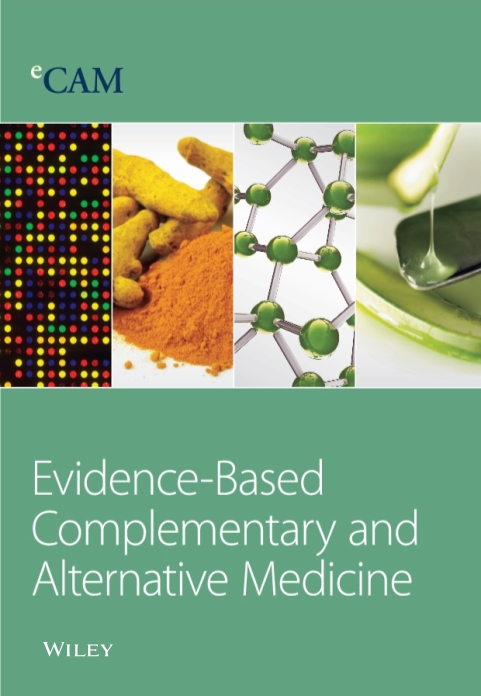异病同治:西尼茯苓煎剂治疗肝癌和慢性心力衰竭的分子机制
4区 医学
Q2 Medicine
Evidence-based Complementary and Alternative Medicine
Pub Date : 2024-04-29
DOI:10.1155/2024/9958258
引用次数: 0
摘要
茯苓水煎剂(PSD)是一种重要的传统中药配方,对肝癌和慢性心力衰竭(CHF)有效;然而,人们对其同时靶向治疗的机制知之甚少。研究方法本研究采用网络药理学方法,包括多数据库检索、药代动力学筛选、网络构建分析、基因本体论(GO)富集分析、京都基因组百科全书(KEGG)通路分析和分子对接,分析了PSD治疗两种不同疾病的潜在分子机制,阐述了PSD治疗LC和CHF的活性成分、信号通路和潜在机制。研究结果共鉴定出 155 种 PSD 活性成分和 193 个潜在靶点。生物信息学分析表明,槲皮素、异鼠李素和柚皮素等可能是潜在的候选药物。TNF、AKT1和IL6等可能成为潜在的治疗靶点。TNF-α、NF-κB、PI3K-AKT和TRP信号通路可能在PSD对抗LC和CHF中发挥重要作用。分子对接结果表明,大多数筛选出的活性化合物都能以较高的结合亲和力嵌入靶蛋白,氢键数≥3表明化合物与靶蛋白的构象较为稳定。总的来说,槲皮素和异鼠李素是主要的活性成分,TNF和AKT1是PSD治疗LC和CHF的主要靶点。结论本研究表明,PSD 所含的槲皮素通过作用于 TP53 关键基因和下调 PI3K-AKT 信号通路,在治疗 LC 和 CHF 中发挥了重要作用。本文章由计算机程序翻译,如有差异,请以英文原文为准。
Homotherapy for Heteropathy: A Molecular Mechanism of Poria Sini Decoction for Treatment of Liver Cancer and Chronic Heart Failure
Poria sini decoction (PSD), a significant traditional Chinese herbal formula, is effective in liver cancer (LC) and chronic heart failure (CHF); however, little is known about its concurrent targeting mechanism. Methods. This study analyzed the potential molecular mechanism of PSD against the two distinct diseases using network pharmacology approaches, including multidatabase search, pharmacokinetic screening, network construction analysis, Gene Ontology (GO) enrichment analysis, Kyoto Encyclopedia of Genes and Genomes (KEGG) pathway analysis, and molecular docking to elaborate the active components, signaling pathways, and potential mechanisms of PSD in the treatment of both LC and CHF. Results. A total of 155 active components and 193 potential targets in PSD were identified. Bioinformatics analysis revealed that quercetin, isorhamnetin, and naringenin, etc. may be potential candidate agents. TNF, AKT1, and IL6, etc. could become potential therapeutic targets. TNF-α, NF-κB, PI3K-AKT, and TRP signaling pathways might play an important role in PSD against LC and CHF. Molecular docking results showed that most screened active compounds could embed itself into target proteins with a high binding affinity, and the hydrogen bonds number ≥3 indicated a more stable conformation of the compounds and target proteins. Overall, quercetin and isorhamnetin were the main active components, and TNF and AKT1 were the primary targets for PSD treatment of LC and CHF. Conclusions. This study illustrated that quercetin contained in PSD played an important role in the treatment of LC and CHF by acting on the key gene of TP53 and downregulating the PI3K-AKT signaling pathway.
求助全文
通过发布文献求助,成功后即可免费获取论文全文。
去求助
来源期刊
自引率
0.00%
发文量
1983
审稿时长
2.2 months
期刊介绍:
Evidence-Based Complementary and Alternative Medicine (eCAM) is an international, peer-reviewed journal that seeks to understand the sources and to encourage rigorous research in this new, yet ancient world of complementary and alternative medicine.
The journal seeks to apply scientific rigor to the study of complementary and alternative medicine (CAM) modalities, particularly traditional Asian healing systems. eCAM emphasizes health outcome, while documenting biological mechanisms of action. The journal is devoted to the advancement of science in the field of basic research, clinical studies, methodology or scientific theory in diverse areas of Biomedical Sciences. The journal does not consider articles on homeopathy.

 求助内容:
求助内容: 应助结果提醒方式:
应助结果提醒方式:


